
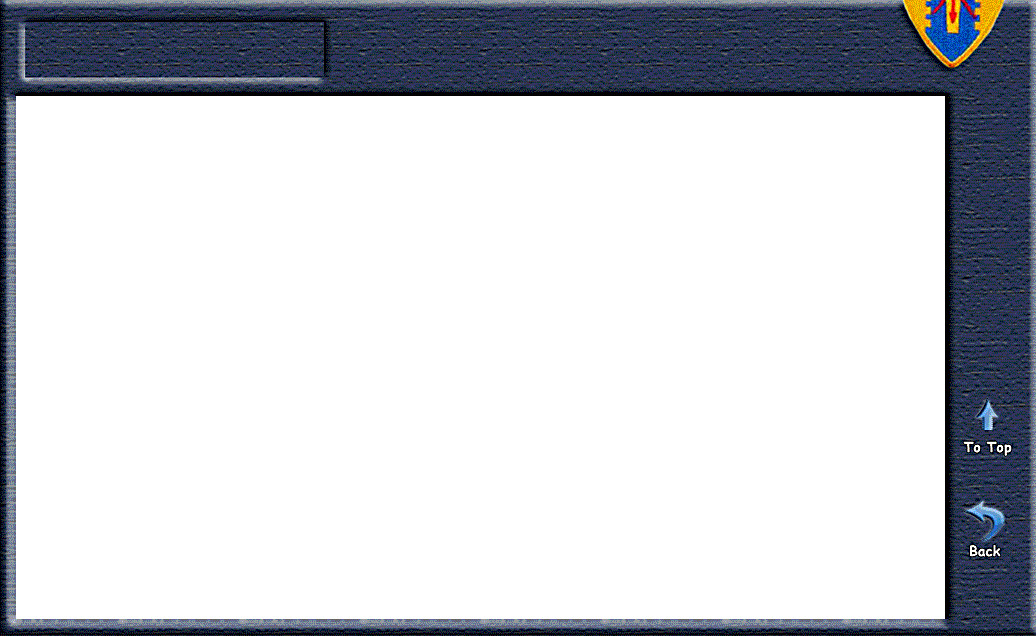
Pat's story of getting to Vietnam, training as a Centaur Gun Pilot, then his first hot mission.
........................................................................................................................................................................................................
My travel time between Flight School and my new assignment seemed pretty short. After a bit over a week with my family in Texas, I flew to L.A. and met my classmate "Atlas" Dixon for a sightseeing trip in California. We saw the coast, Yosemite, L.A. and San Francisco. My last trip to San Francisco had been as an Army Dependent, enroute from Okinawa. Although it had only been four years, it seemed like forever.
A particularly memorial tour in Frisco was to Haight-Asbury, a run down district of the town that the hippies had made into their neighborhood. Dixon, myself and a few other of our classmates who we had met later in town got into uniform and had our pictures made standing under the street sign proclaiming the Capitol of Hippiedom. The flower children were somewhat taken aback by these young warriors invading their territory, knowing that we were probably off to do the devil's work, raping women and killing babies in a foreign land. In their peace loving manner, they yelled at us, calling us every bad thing that they could conjure, flipping us off, with one of them even pulling a knife on us. One of his less drugged-out friends pulled him away before any of us got into some trouble, but let it be said that in our current mindset, we were not about to take a threat of that sort lightly. We, having been recently proclaimed Warrant Officers, were almost gentlemen by Act of Congress, so after some taunting of our own, left the Love Generation to do whatever it was that they wanted to do. We had more pressing business just ahead.
Prior to shipping, or rather flying, out, we stayed in BOQs in Oakland. There we waited for our specific shipping orders to Nam. The day came all too soon, and several of us proceeded to get roaring drunk at the O Club. Getting on the Continental 707 was little more than a foggy memory for me, and I was fast asleep before we became airborne. My best recollection of the flight is when the pilot announced that we had lost an engine and were returning to Travis AFB. I then groggily noticed that there was nothing but ocean below us. Great! We are going to crash before I can get a chance to get killed in Vietnam! But we returned, changed planes, and my chance to lose my life in a war zone was revitalized.
We refueled in Hawaii, and then made the remainder of the hop to Tan Son Nhut Air Base in Saigon. As we made our long final approach into TSN, I had a window seat on the starboard (right) side of the aircraft. Looking west, I could see that there was a war in progress below us. Our plane was landing just before dawn, and several flares were visible from my window, floating lazily in the sky, creating an eery, reddish light. I couldn't make out anything specific, but the strange light from the flares was reminiscent of the "rocket's red glare, the bombs bursting in air," and it was plain that we weren't in Kansas anymore. In fact, we were about to enter another world, far removed from what heretofore we had known.
Even in the early morning, stepping off the plane at Tan Son Nhut was like walking into a sauna. It was late August, and the heat was oppressive, even to someone who had recently been stationed in southern Alabama. Maybe this wasn't going to be a lot of fun. We were quickly escorted to waiting buses. Although they looked similar to the Army buses that I had ridden for years, these had barred windows, so that the VC couldn't throw grenades into our transportation to Long Binh, where the replacement center was located. On the way to Long Binh, our buses were escorted by MPs in jeeps with machine guns front and rear, and the Spec 4 in the front of the bus was armed as well. In my infinite wisdom, I caught on that the road between Saigon and Long Binh, although heavily travelled by US and ARVN (Army of Vietnam) troops, was not secure.
Our trip to Long Binh was short and uneventful. Officers and Warrants were given billets in wooden buildings known by everyone as hooches. The "enlisted swine" had large tents for their short term barracks. We were processed in, and given a couple of options as to where we might be assigned. I chose the 25th Infantry Division, for no reason in particular. In a day or so, I was on an airplane enroute to the Division basecamp in Cu Chi.
The flight was short. Cu Chi was located about 30 miles northwest of Saigon, so the flight from Long Binh took only a few minutes. Located in the Army's III Corps, the terrain was pretty flat. We flew over villages, numerous waterways, jungle, and much land that had been pock marked with bomb craters. The letdown to Cu Chi was to runway 18, a hastily built runway made of PSP (Perforated Steel Plating), which the military used for all sorts of construction. 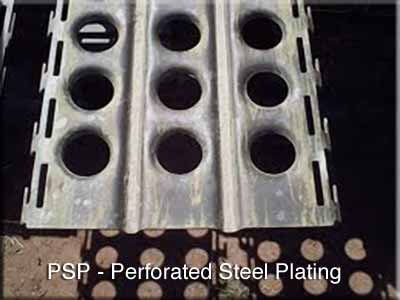
PSP was an OD (Army Green) colored (of course) steel which could be linked together quickly to make bridges, roads, buildings, or just about anything else that needed to be built efficiently and without a lot of engineering technology. I would see a lot of PSP in the next year.
The transport, an Army Caribou, made a combat approach, a full flaps/high angle of attack landing that put us in harm's way from enemy fire for the shortest amount of time possible. As I had learned in flight school, our "dead man's zone" was from 500 to 1,000 feet above the ground. There, we were very susceptible to small arms fire. The Caribou pilot had evidently been to the same class, because he did not tarry in those altitudes.
We touched down at my new home. The odor of burning human waste was permeating the air, a strange smell that once noted by your olfactory organ is cataloged and never forgotten. Few military installations in Vietnam had sewage systems (I heard of some, but never had the pleasure), and when downwind of a base like Cu Chi, the smell of burning shit was evident for miles. Junior enlisted personnel were assigned the "shit detail", which was pulling out the large collection drums in the latrines, dousing their contents with JP4 aircraft fuel or diesel, and lighting the match.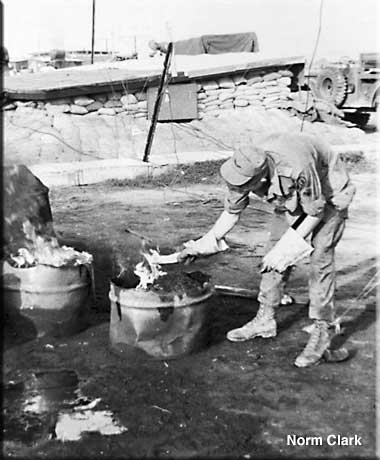
Many black smoke plumes from the burning crap were visible daily in every basecamp in Vietnam. At Cu Chi and most other places that I was, urinating was officially into "piss tubes", which were usually casings from some type of armament that had been dug into the ground. When that location was full, it was moved a few feet. Unofficially, troops pissed pretty much where the urge took them.
My time at the 25th Replacement was short. I was assigned to D Troop, 3rd Squadron, 4th Cavalry Regiment. The basis of the assignment was that there were openings in the 25th Aviation Company or D Troop. When I asked the Spec 4 clerk what the units did, he said that the 25th Aviation Co. mainly flew slicks, and the Cav mainly flew guns. This, I suspect, was about the total knowledge that he had of the two units. I chose the Cav with the hope that I might get to fly guns. As the saying goes, don't wish too hard, you might just get what you ask for.
D Troop sent a jeep to pick me up, and I reported to the CO. Since the CO was out, I actually reported to the XO, a major whose name has been erased by time. He was one mean looking, all business, soldier, who had a shaved head and a large handlebar mustache. He welcomed me to the unit, and gave me a brief explanation of what Delta Troop was about. D Troop's call sign was Centaur, and I had just become one.
Armored Cavalry was and is the eyes of an infantry division. D Troop was the air arm of the squadron, which consisted of a Headquarters Troop and three ground troops. Alpha, Bravo and Charlie Troops were armed with tanks, armored personnel carriers and mounted infantry. It was the Cav's mission to scout for the Division, often to be the front of any Division movements, and also to be escorts for convoys moving from Cu Chi to other camps such as Tay Ninh or Dau Tieng, both of which were the 25th's "sub basecamps", jumping off places to War Zone C and the Iron Triangle, names which were of no meaning to a new Warrant Officer, but which would become very significant in months to come.
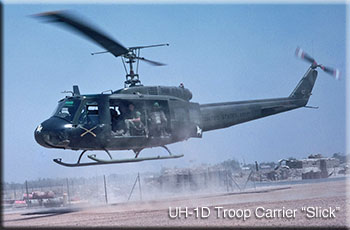
The XO explained that the Centaurs consisted of a platoon of aero-scouts, which included the OH-23G Raven light scout recon helicopters and the UH-1B/C heavy scout gunships; "aero-rifles", infantry whose mission was generally small scouting assignments or small scale Search and Destroy, the Slicks, which were pilots and crew of D model Hueys who did a variety of missions, including lifting the aero-rifles into landing zones and resupplying them, flare missions, med evacs, C and C (command and control), and general "ash and trash", which was an all inclusive term for lots of non combat flights.
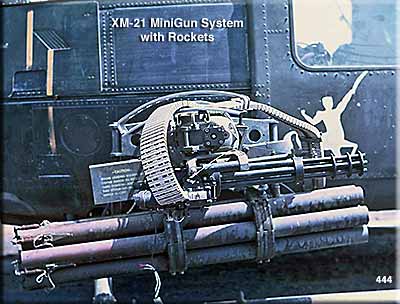
The Gun Sections contained two different types of gunships, the heavy scouts and the "frogs" and the "hogs". The heavy scouts were B and C model Hueys, armed with either 4 M60 machineguns and 14 rockets(the XM16 system) or miniguns and 14 rockets(XM21). They generally flew lead in a light fire team (LFT), and did a lot of low and slow flying at treetop level, hence their "scout" name. They also performed a variety of other missions, most often that of direct fire support for ground units that were engaged in combat, or such things as bomb damage assessments (BDA), counter mortar assignments, convoy cover, or flying cover for defoliation missions and scouting missions where the lighter scout aircraft were utilized.
The Hogs generally flew trail behind the heavy scouts, and carried an M5 40mm grenade launcher in the nose of the aircraft and rocket pods capable of carrying a total of 48 rockets. They were the heavy fire support, with "heavy" being a description of both their capabilities and their gross weight. The gunships all carried both a crewchief and a gunner in back, each armed with M60 machineguns and around 1000 rounds of ammunition per flight, along with various grenades, including fragmentation, smoke, and willie peter or white phosphorous. The final combat component of D Troop was the Scout platoon, which at that time consisted of pilots and crew that flew in OH 23s, the same tiny, gutless helicopters that we had learned to fly in at Wolters. While we flew D models in flight school, the Vietnam, big time combat 23s were G models, which gave them a bit more power but no less vulnerability from small arms fire.
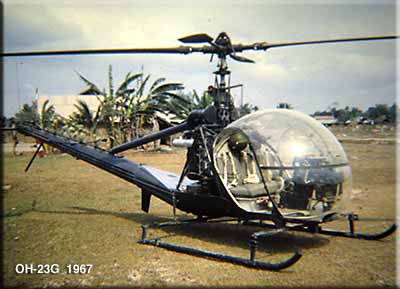
It was the mission of the scouts to fly even lower and slower than the Huey scouts, looking for trouble, which they often found in abundance. The 23s could carry a crewchief/gunner with an M60, and there was another 60 attached to one of the skids. Their firepower was hardly awesome in comparison to that of the UH-1.
When I reported to D Troop, there were openings in Heavy Scouts and Slicks. The XO actually gave me the choice, and I immediately picked the guns. Of course, if any of the current Slick drivers had wanted to transfer to guns, I would not have received such a choice, but they all apparently had better sense than to pick Heavy Scouts. So, I was assigned to the Gun Platoon, having no time in country, and little more than an orientation ride in gunships.
My quarters was a GP tent, but it did have a wooden floor. There were 4 of us per tent, so we had a bit of our own private area, including a cot and space for a footlocker. My personal gear finally caught up to me after I had been in country about a month, so all I had for uniforms was what I had stuffed in my duffel that I hand carried on the plane coming over from the "world". But I was soon issued jungle fatiques, jungle boots, flight gear, and other necessities, like a 45 auto, shoulder holster and ammo for my arm of last resort. I had never been any good with a .45, and I proved my ineptitude with my new issue, but at least in Vietnam we had .45 tracers, so you could see how badly you were missing the target.
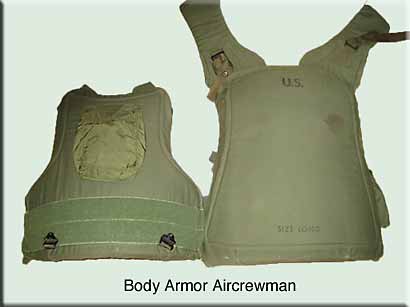 One much appreciated item of flight gear was my "titty protector" (or "Chicken Plate"). The protective vest was a large plate of ceramic, which weighed several pounds, and which the pilot strapped on to protect from frontal shots. I was told that the plate would stop a round from an AK47 or similar type of small arm, so I got very attached to it very fast. I was also issued a flak vest, which would not stop small arms fire but could protect the upper torso from shrapnel, and made a new guy feel very dashing when wearing it around camp, at least for a couple of days. After hearing from the veterans about the FNG (fucking new guy) trying to look like John Wayne, the flak vest was only worn while the camp was under attack, which didn't take very long.
One much appreciated item of flight gear was my "titty protector" (or "Chicken Plate"). The protective vest was a large plate of ceramic, which weighed several pounds, and which the pilot strapped on to protect from frontal shots. I was told that the plate would stop a round from an AK47 or similar type of small arm, so I got very attached to it very fast. I was also issued a flak vest, which would not stop small arms fire but could protect the upper torso from shrapnel, and made a new guy feel very dashing when wearing it around camp, at least for a couple of days. After hearing from the veterans about the FNG (fucking new guy) trying to look like John Wayne, the flak vest was only worn while the camp was under attack, which didn't take very long.
I believe that I got my first taste of "incoming" the second night that I was with D Troop. The troop area had several bunkers that were there in case of a mortar attack, but I had no idea how often I would get to look at their sandbagged walls during my tour. A divisional basecamp has artillery firing outgoing rounds almost constantly. At first, an FNG hears the outgoing and does not know whether the crashing noise is that of rounds landing or leaving the tubes. When the outgoing artillery fires, at first it is quite unnerving. After a short time, it becomes a sound that gives a feeling of security. I was in my second night of fitful sleep in D Troop when a sound that I didn't discern as much different from artillery being fired got my hoochmates up and running for the bunker."Incoming, incoming", was being yelled from all the surrounding hooches. One of my hoochmates yelled, "To the bunker, that's INCOMING, asshole!" I hit the wood floor on a run, making for the bunker. The incoming mortar rounds had a crunching sound that is hard to describe to someone who has never heard it, but after hearing only a very few, I could discern between incoming and outgoing.
 Since our hooches were immediately next to the flight line/runway, our area was a prime target for mortar attacks, and I became all too used to them over the next several months. When we were getting mortared at this time, it was usually from 81mm stuff. Later, when mortar attacks graduated to 122mm rocket attacks, I got a taste of what true fear was, but the 81s were plenty scary, particularly when they were hitting just a few meters from your bunker. Our bunkers would not withstand a direct mortar hit, but protected us from anything that did not land squarely on top of us, so during the attacks we would just hunker down and try and judge how close the mortars were landing. We all were quickly experts at just how close a round had landed, and after a couple of weeks and several mortar attacks during the middle of the night, they were already becoming frighteningly normal.
Since our hooches were immediately next to the flight line/runway, our area was a prime target for mortar attacks, and I became all too used to them over the next several months. When we were getting mortared at this time, it was usually from 81mm stuff. Later, when mortar attacks graduated to 122mm rocket attacks, I got a taste of what true fear was, but the 81s were plenty scary, particularly when they were hitting just a few meters from your bunker. Our bunkers would not withstand a direct mortar hit, but protected us from anything that did not land squarely on top of us, so during the attacks we would just hunker down and try and judge how close the mortars were landing. We all were quickly experts at just how close a round had landed, and after a couple of weeks and several mortar attacks during the middle of the night, they were already becoming frighteningly normal.
I was only a couple of days in my unit when I got my first ride, which was both a checkride to see if I could remember how to fly and an orientation ride to begin to learn the AO (area of operations). My trainer and aircraft commander was Mark Schmidt, another Warrant Officer who had been in country about 6 months, rendering him a hardened veteran. He let me preflight, crank and hover the Huey, while he took care of radio procedure. I immediately found out that a fully loaded gunship in the heat of Vietnam did not want to hover. Schmidt taught me that in order to get the helicopter in the air, I would have to make a running takeoff, bouncing the aircraft several times until our airspeed reached translational lift, where the helicopter's rotor got into undisturbed air and began to fly. I wallowed around, trying to make the thing hover like we could in flight school, each time running out of power and having the helicopter settle to the ground. After a while, my PT (pilot technique) became adept enough that I actually could get the overloaded aircraft to do somewhat of what I wanted it to. As we climbed out of Cu Chi that first time, Mark showed me different sights which would soon be normal, but was almost overload to a new, wide eyed Wobbly One fresh from the world. I made a few takeoffs and landings under Mark's watchful eye, and then we proceeded to an area just south of camp named AO Earp. Earp was an area that gunships practiced fire and tested weapons. On my first flight, Mark flew in the left seat, where the flex sight for the M16 machineguns was located. He showed me the basics of how to make a gun run. Start at about 1000' (yes, the dead man's zone), drop the nose into a steep dive, fire on the target, and break out at around 300' to 500'. He flew the first couple of runs, firing rockets singly from the button on the cyclic, giving me an idea of what I should be able to hit from my right seat position. When he fired, using no sight, his rockets hammered the old APC that was our target. He then gave me the aircraft, after having me pull down my rocket sight, which had a small red pipper targeting where the rockets should impact. I tried a couple of dry runs, keeping the helicopter in trim with the pedals, lining up the rocket sight on the target, and then breaking out of the run on Mark's command. The short amount of time during the run could give a pilot target fixation if he was unskilled, making it where the aircraft might not be able to pull out of the run in time to avoid crashing, so Mark was teaching me to get set up and on target quickly. When I finally did punch off a couple of rockets, I came pretty close to the target. On my next pass, I actually hit the APC. Mark had me make another run, but this time, without telling me, he had the gunner and crewchief open up with their M60s and he fired the four M60s on the M16 system. My rockets came nowhere near the APC this time. The noise and vibrations, not to mention the numerous tracers flying by just out my door, had my accuracy off. But after another pass or two, I started to get a bit more of a feel for how to do this, which was going to be a large part of my job for the next year. We returned to Cu Chi, got another ship that was equipped with minis, and repeated the lesson. Again, I flew the right seat, and soon found that the miniguns , with a normal rate of fire of 2400 rounds a minute of 7.62mm each, were awesome in their noise and firepower. Instead of hearing individual rounds going off, the mini sounded like an extended growl or roar. The tracers were spaced in the belts every fifth round, but still looked like a solid blanket of bullets racing towards their unfortunate target. Even after a year's tour, the sound, look and feel of a gunship firing both minis, rockets, and crew firing both M60s was almost surreal in its overwhelming destruction capabilities. The first time or two was an adrenaline rush which was hard to describe.
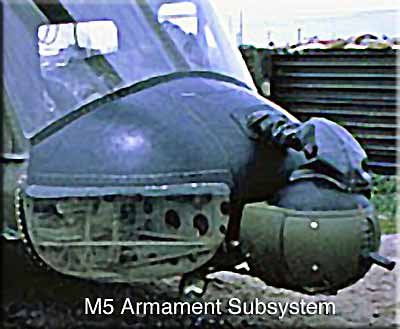
In my first few days in country, I was also qualified in the M5 "chunker" and the large load of rockets it carried, even though I was assigned to fly heavy scouts. A gunship pilot needed to be familiar with all the weapons in the arsenal. When the chunker went off, the whole aircraft shook violently as the rounds left the tube. I was shown a salvo of the rockets, where all 48 rockets lit at once. It felt like the helicopter was almost backing up when we salvoed, and the sparks, noise, and smoke from 48 rockets lighting up from a position only a few feet behind our seats was impressive, to say the least. When they impacted, they obliterated the area with shrapnel from the 10 pound high explosive warheads that they carried. It was hard to fathom how anyone or anything could survive such an awesome display of destruction. The fact was, anybody caught in the open when such terror was raining down on them was almost always killed.
I began to learn about gunship tactics. Instead of flying the tight formations that the Slick pilots did for a living, guns flew "tactical trail", with the second or trail ship flying well behind the lead so that if lead got shot at, the trail would have time to react and fire upon the enemy. Trail usually flew well above the lead ship, as well, and off to one side so that their line of receiving fire would be somewhat different. When the heavy scout was down low and slow, trying to find targets of opportunity or draw fire, the trail ship would fly higher so that accurate fire could be brought against enemy positions.
Schmidt taught me how to perform a "snap shot", at first one of the scariest maneuvers that I had been through in a helicopter. Flying trail, Mark would say, "Lead just received fire from that stream intersection," which just happened to be almost underneath our aircraft. He pulled back violently on the cyclic, kicking our nose into the sky, while dumping the collective to gain rotor rpm. Then, he rolled the nose over into a steep (and I do mean steep) dive. It felt as if we were diving directly into the ground, and I swear that you could feel the tail of the aircraft trying to come over the top. Since Hueys don't fly very well upside down, this is a feeling that is very disconcerting and certainly a maneuver that we never tried in flight school. As soon as he had the helicopter screaming for the ground and the target directly below us, he punched off a couple of rockets, which nailed the stream intersection, and then he broke the run with a violent turn, pulling the aircraft out of its dive. The first few times that I sat through this, I wondered if I shouldn't be flying slicks, after all. It took me a lot of practice to be able to perform this to Mark's satisfaction, but I finally got it down to where he didn't fear our immediate death when I was at the controls.
After about a week of orientation to how to drive a gunship, and a couple of day flights to become oriented to the AO (our Area of Operation), I was deemed worthy to fly my first night mission as Peter Pilot. This was to be a convoy cover mission, with a convoy heading northwest on Highway One from Cu Chi to Tay Ninh. After being in country a few months, I would have questioned the wisdom of a night convoy, but at this point in my tour, I was basically ignorant of the truism that Charlie owned the Night. It didn't take long into this first mission to see that night convoy cover missions would be full of excitement. The convoy was led by a tank, then a couple of APCs, with the supply trucks sandwiched between other tanks and APCs as rear cover. Only a couple of clicks out of Cu Chi, Charlie hit a lead and rear APC with RPG rocket launchers. Suddenly, the ground below us became alive with tracer fire going in opposite directions. A flare ship above us started popping flares, and we saw dozens of figures running away from the highway towards a nearby village. Their main tactical mistake was in being in the open, and we immediately rolled in on them, with Mark yelling at me to fire the minis, as he, flying the aircraft from the right seat, started to fire rockets into the VC troops. Although basically unskilled in the operation of the miniguns, I put the sight on a group of fleeing VC, and let fly. Minies were loaded "4 and 1" tracers, that is, every fifth round was a tracer round. The effect, however, is that the sky is filled with red lights racing towards the target, and knowing that for every round you see there are four more is truly awe inspiring. The roar of the minis was punctuated by the rat a tat tat of the gunner and crewchief's M60 machineguns, interspersed with the "Whoosh" of rockets being fired from a few feet behind your head; all in all, a display of power and destruction which is tremendous.
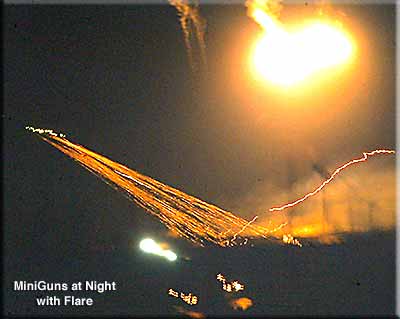
The enemy, of course, did not take this type of challenge lightly. As we rolled in and initiated fire on the retreating VC, they returned it, and for the first time in my life I saw and heard automatic weapons fire pointed at me. Their tracers were green, while ours were red, and as their fire passed our aircraft, distinct pops could be heard, even with all the noise that we were causing. During these gun runs, it didn't occur to me that I should be frightened. I was concentrating too hard on doing my job to be scared. That, I was to learn, would come later, after I had time to contemplate what we had just been through.
Our fire was effective. Mark's rocket fire was hitting pockets of VC, and my spraying of the countryside with the minis had an effect, as we saw after a couple of passes and the enemy resistance stopped. The ground element made a S and D (search and destroy) sweep through the village, and as they did we circled at a low altitude, admiring our work by the light of the flareship. I was amazed to see not only human bodies, but dead cattle, pigs, and other livestock that had been in the way of the VC retreat. The only thing moving in the light of the flares was our troops, some walking, some in APCs. We stayed on station for some time, and then returned for fuel and rearming. When we returned, we were told by the ground troops that they had a Body Count of 52. This, I was to learn, was very high for our short encounter. The US had lost 2 KIA and two tanks had been destroyed. Several US soldiers had been wounded in the firefight, and were helicoptered back to Cu Chi by "Dustoff", the medevac bird.
Our aircraft had not been hit, nor had our wingman. Mr. Charles was no doubt opting for the type of markmanship common when automatic weapons are employed in a fight, that of "spray and pray". As my experience in Vietnam progressed, I would see many instances of the spray and pray philosophy put to use, from both sides. I would also see VC and NVA taking unbelievably precise aim at their attackers, and maintaining fire discipline that made my job much more dangerous and difficult, but on this night, my first firefight, I was luckier than that.
That first firefight was in many ways typical of firefights to come. Often, a brief glimpse of the enemy was all we got, but we did get to view a lot of fire coming in our direction. Since we owned the air, we did not have to worry about any bogies, and only had to concentrate on the ground forces. The actual fighting was fairly short, and highly intense. Our bodies had to be near overload status on adrenaline. Fear came later, because during the conflict we were just too busy to think about anything but the job at hand. And the sounds were as overpowering as anything that can be imagined. The actual sounds of the weapons would be quite enough in and of themselves, but we also were yelling at each other on out intercom, listening to the FM radios of the ground troops, as they, too were involved in some intense fighting, and then we further were talking and listening to our wingman, the flareship, and quite often the C and C (command and control) aircraft, who while well out of harm's way usually, still had to be "part" of the action via "directing" his troop. I can imagine nothing more intense than a big firefight. I was at the beginning of a year of intensity that a year before I could only guess at, and still would have been way off the mark.
Pat Eastes
® All Rights Reserved 2014